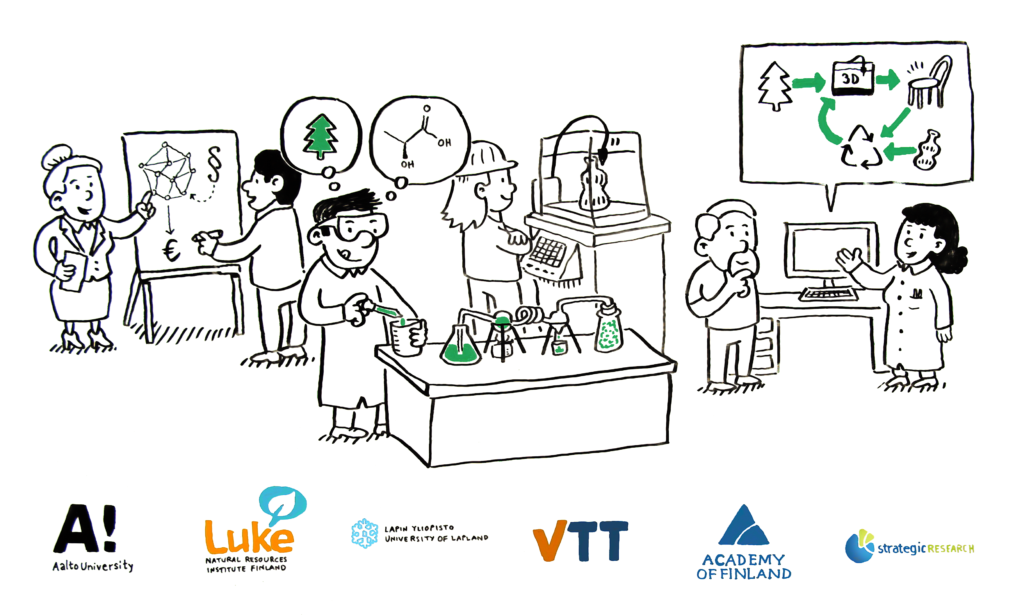Author: Lars Vilen, Jaakko Siltaloppi / Aalto University
The current linear economy model of plastics production and consumption entails a number of issues, including the leakage of plastics waste into the environment. Certainly the most salient issue from a political perspective, the environmental problems with plastics have induced a variety of political actions especially in the EU. Ban on landfills and single-use plastics, along with demanding targets for plastics recycling, are quickly changing the landscape for companies producing, converting or using plastics.
In this context, new models for the reuse and recycling of plastics are urgently needed to transition the plastics value chain from linear to circular mode. In the ValueBioMat project, we conducted an exploratory study to locate emerging models in plastics recycling, and to identify factors that enable and inhibit the development of these models in the present-day economic and political landscape.
Based on expert interviews and the analysis of 62 emerging recycling concepts, we located three key areas of development with distinct business models and development success factors:
- Technology business models
- Reuse business models
- Material processing business models.
First, a number of companies are operating on a technology business model. This model focuses on improving existing and creating new technologies for sorting, collecting and/or processing plastic waste. Business-wise, these business models are based on offering technologies to recycling operators with improved efficiencies and/or higher yields. New businesses and offerings in this category were emerging particularly around chemical recycling, the different technologies of which show significant potential at the moment for increasing the recycling rate of plastics suffering from low quality and high heterogeneity. The success of these business models is based on technological and R&D capabilities. The availability of capital for the development and testing of technologies is also critical for such business models to establish a viable technology and scale up production for the growing market. For example, many oil companies are currently investing in the development of chemical recycling either through in-house R&D or investment in start-up companies.
Second, a distinct business model category emerged around circular / reuse business models. In this category, companies share focus on creating service-based solutions to replace single use plastics with a circular flow of reusable products. In other words, they take the responsibility for the whole chain of collection – processing – reuse for the customers wanting to replace single-use plastics with more sustainable solutions. For example, new models are emerging to replace single-use packaging in takeaway food with reusable packaging. While relatively simple to set up due to low operational complexity and cost, companies struggle with matching the price level of single-use packaging. Moreover, capital for scaling up such models was not yet easily available due to the uncertain business case, perhaps mirroring the uncertainty about the importance of sustainability as criterion in consumer decisions.
Third, companies focused on operating the logistics and/or processing stations were grouped under the category of material processing business models. As the label suggests, these business models are set up to take the responsibility for operating one or more parts of the collection, sorting and processing value chain of plastic waste. In Finland and elsewhere in Western Europe, this is typically done in close collaboration with public and private actors responsible for organizing the appropriate handling of the plastics waste for consumer and industrial waste. The success of such business models depends on the efficient logicstics and processing of large streams of plastics waste. Furthermore, advances in the purity and quality of the recycled fractions (using new technologies—see the first model) increase the market value of the output. While the EU-level targets on recycling rates drive the growth of these operations across Europe, a significant business-related challenge is the currently negative value of plastics waste. This de-incentivises the market-driven development of the material processing operations, alongside the currently limited demand for lower-quality recycled fractions.
The discussed business model archetypes outline three distinct avenues for the business-driven development of plastics recycling. They highlight, first, a need for technological, operational and service innovations to increase and improve plastics recycling at a systemic level. Second, tapping the complementarities and synergies between the recycling business models through cooperative innovation processes is important for this systemic transition to gain momentum.
———————————————————-

